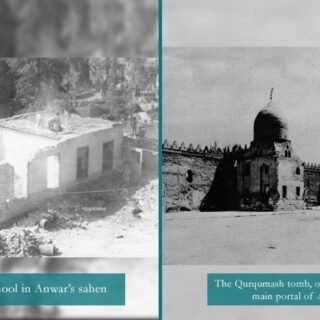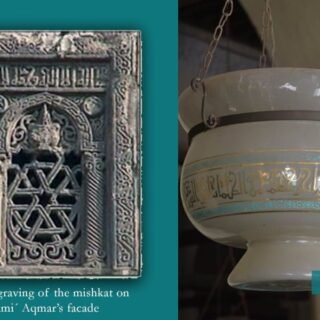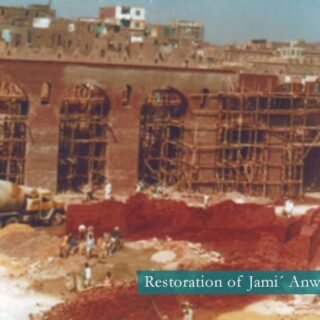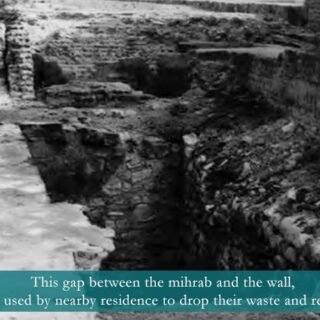The Mishkat al-Anwar, and its design, is ubiquitous. It is found in dawat buildings all over the world. Be it a masjid or a qubbah or a madrasah, this lantern illuminates the path of guidance for the faithful. Along with Libaas al-Anwar, it is one of the most apparent symbols of Jami´Anwar’s barakat. During hajj, Mumineen pilgrims converge under the symbol of the mishkat, a symbol that distinguishes us from the hundreds of thousands of others undertaking this sacred journey.
Yet, just forty years ago, this design was another hidden Fatemi relic, and like many other such relics, it was destined for the Fatemi Dai, Syedna Mohammed Burhanuddin RA to reveal it. The 7th aayat of Jami´ Anwar’s restoration is the Mishkat al-Anwar. In the original construction of the masjid, Imam Hakim AS had placed it in 400 lanterns. When the time came to place lanterns in the newly restored masjid, great discussion took place. One morning, Syedna Mohammed Burhanuddin RA glanced at the stone façade of Jami´ Aqmar, the last masjid constructed by the Fatemi Imams AS, and pointed to the design of a lantern hanging in a window, engraved upon it. The design is found in stone windows engraved upon both sides of the masjid’s facade, and the symbolism and meanings entailed in it were revealed in today’s waaz Mubarak by Syedna Mufaddal Saifuddin TUS.
Tears from Stone
Just as the mishkat was derived from a design found in stone, Duat Mutlaqeen, and especially Syedna Mohammed Burhanuddin RA repaid the great debt of Imam Husain’s AS grief and lament by drawing tears from stone, from the walls of mazaaraat: Taherabad, Ahmedabad, Hutaib Mubarak Raudat Taherah, and also from those with hearts of stone.
Miskhat means the niche in which one places a lamp, a misbaah. The light of the mishkat is that very light which originates from the eternal realm, its beams guiding us back towards it. This light is the Imam and in his seclusion, his Dai. Today’s waaz mubarak established the distinction of Maula’s light over that of the celestial sun.
To preface this distinction and superiority, we heard the narration of Hafsah b. Noman, who during the Battle of Siffeen, left his camp at night and proceeded towards the desert. As he was walking, he saw a light shining from a lantern, carried by someone. He began to walk towards it. The closer he came to it the dimmer the light became, until he came before the person who turned out to be Amirul Mumineen AS.
Near in his greatness, great in his nearness
Following this narration, Syedna al-Dai al-Ajal TUS directed the entire majlis to recite the Ayat al-Nur, which they did in unison. Then reciting phrases from the du´aa’ mubarak of Imam Ali Zain al-Abedin AS, he explained that this narration reveals one of the glories of Maula: ‘Near in his greatness, great in his nearness’. The sun is the king of all stars and planets but has been placed in the fourth sphere, as close to Earth as it can possibly be. If it was any closer the intensity of its heat and light would prevent life from flourishing on Earth. A surface temperature of 5500 degrees and a core temperature of 15 million degrees limits how close it can be to us, despite its greatness. Prolonged exposure to it whitens our clothes, and burns our skin. Similarly, when one ascends a mountain, the higher he climbs the more the lack of oxygen affects him. However, Maula is such a mishkat that even though one may come close to it, its light guides – it does not blind; its heat grants life – it does not burn. Likewise, despite his mountain-like stature, the one who assails heights in the comprehension of his glories will enhance his faculties. This is apparent during the last rites of the slave of Bani Riyaah. Rasulullah SA led his funeral for which angels had descended from the heavens. This was because whenever he met Maulana Ali AS he would profess to him, ‘By Allah, I have mohabbat for you, my Maula’. When a Mumin is laid to rest, he is covered by the earth. Yet, the level of spaciousness he senses on either side of the grave is equivalent to the distance one would cover when walking continuously for a month. Those Mumineen who genuinely respect the greatness of Maula, will be raised by him to heights of greatness.
Like clothes and skin, this radiance and darkening was also seen when Maulana Ja´far al-Tayyaar RA took a group of Muslims to Abyssinia to seek refuge with the Emperor al-Najaashi (Negus). The noble Christian emperor gave them shelter, and was, eventually, so taken aback by the message he heard and the nobility of Maulana Ja´far RA and his companions, that he converted to Islam. This was in spite of efforts of the chasing envoys of Quresh who were smugly expecting the Najaashi to forsake the Muslimeen and hand them over to them. They felt that Nabi Mohammed’s SA new religion would be dismissed as blasphemy to their Christian beliefs, but when verses from the Quran were recited before them, the Najaashi and his bishops wept, leaving the adversaries ashen-faced.
This nearness is not gauged by physical proximity. Many of those who were physically close to Rasulullah SA were as far from him as one can get. They are like the rocks that lay near Niagara Falls. Despite the thundering force of the water, they remain bone dry. Syedna al-Dai Ajal TUS commented on how close Shimar was to Imam Husain AS, yet he unable to see even a flicker of this radiant mishkat. On the other hand, a Mumin in peril, in a car being faced head-on by a truck, just needs to call out Ya Ali, and the impending tragedy is averted.
Syedna Mohammed Burhanuddin RA affection on children was remarkable. They, like adults, could all easily approach him. Syedna al-Dai al-Ajal TUS counseled that one dimension of a parent-child relationship is that they should be like friends to each other. Similarly, al-Dai al-Ajal Syedna Abdulqadir Najmuddin RA was asked how he managed to sleep at night considering the tense and difficult affairs he faced. He replied, whenever I leave the sitting room, I bundle up my worries and place them in one of room’s niches to be reopened the next day.
‘Near in his greatness’ is exemplified by Imam Ali Zain al-Abedin AS. On the day of Ashuraa’, all but Imam Husain AS had attained shahaadat. Imam Zain al-Abedin AS attempted to lift his sword and venture out on to the battlefield. However, he did not have the strength to do so. This was how close he was to going in to battle. Imam Husain AS halted him, saying that it was his destiny to ensure the continuation of the imamate in Imam Husain’s AS and his progeny. Thus, Imam AS sacrificed his desire to sacrifice himself for Imam Husain AS.
In Madeenah Munawwarah, Imam Ali Zain al-Abedin AS continued to demonstrate the nearness of Awliyaa’ Allah AS, despite their greatness. When he passed away, there was a mark on this shoulder, in addition to those on the parts of his radiant body which touch the ground during namaaz. Only Imam Mohammed al-Baaqir AS was aware of the reason behind the mark on his shoulder, and it was only in Imam Zain al-Abedin’s AS passing did he divulge the reason. Each night, Imam AS would direct his cook to prepare quantities of food far greater than the requirements of the household. Then, late at night, once everyone had retired for the day, he would carry a skin full of food on his shoulder and proceed towards the impoverished sections of Madeenah. When one skin became empty, he would return home to refill it, often returning multiple times during one night. He did this at night, so that no one would recognize him, and he took it upon himself to feed the hungry rather than delegating the task to a servant. On a night when he happened to arrive at their homes later than usual, children would come upon the doorsteps of their houses and call out ‘where is the ‘mashkiwala’, the food-bearer’. Such was the greatness of his 1000 rak´ats of namaaz a day and the deed of providing for 100 households.
This tradition of providing for others has continued over the ages. Al-Dai al-Ajal Syedna Ismail Badruddin RA began the tradition of providing lodging and boarding for students who came to the presence of the Dai al-Zaman to seek knowledge. Likewise, Syedna Mohammed Burhanuddin’s RA grand initiative, implemented by Syedna al-Dai al-Ajal TUS, Faiz al-Mawaaid al-Burhaniyah, has spread worldwide. This noble program has ensured that no Mumin ever goes to bed at night hungry.
Like all values and principles, this greatness and nearness was also seen in Karbala. After they had fallen, Imam Husain AS came to each shaheed and carried him on his shoulder to a place where he had gathered their bodies. How much closer could anyone be to Imam Husain AS than to be carried upon his shoulders – the Maula who Rasulullah SA placed upon his shoulders – their bodies touching his divine one.
In order to further raise Mumineen, Syedna al-Dai al-Ajal TUS directed Mumineen to conduct majlis in their homes, with the intention that there be at least one hafiz al-Quran in each home. Likewise, he stressed that our business practices should abide with the tenets of sharia. If Mumineen enter in partnerships with their fellow brethren, then the terms and conditions of the agreement should be clearly documented in accordance with the laws of the land. Finally, he drew our attention to those who attempted to deny us the nearness and greatness Maula wished to offer us. In their enmity and arrogance, the four manaahis who were in Jamea used to claim that ‘Is there anyone who can make us shed even one tear upon Imam Husain AS?’ Today, by the efforts of Syedna Mohammed Burhanuddin RA and Syedna Mufaddal Saifuddin TUS such impurities have been cleared away. Maula has drawn so near t him, that when even a young child of five or six years of age stands before us and recites the shahaadat of Imam Husain AS, the entire majlis breaks out in bukaa’ and maatam.
Syedna al-Dai al-Ajal TUS made it explicit that regardless of the county one resides in, there is no need for anyone to have any inhibitions when it comes to expressing the grief and lament on Imam Husain AS. Come what may, there is no need for us to fear. It is with this clear message reverberating in our hearts and minds, that we prepare ourselves for expressing noh and aweel on the day of Ashuraa’. This expression is of utmost importance. This expression is salvation.







